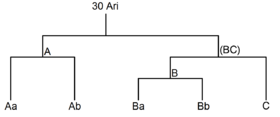This is an old revision of this page, as edited by Lithopsian (talk | contribs) at 20:31, 29 December 2020 (number of components uncertain). The present address (URL) is a permanent link to this revision, which may differ significantly from the current revision.
Revision as of 20:31, 29 December 2020 by Lithopsian (talk | contribs) (number of components uncertain)(diff) ← Previous revision | Latest revision (diff) | Newer revision → (diff) 30 Arietis star system hierarchy | |
| Observation data Epoch J2000 Equinox J2000 | |
|---|---|
| Constellation | Aries |
| 30 Arietis A | |
| Right ascension | 02 37 00.5235 |
| Declination | +24° 38′ 49.9880″ |
| 30 Arietis B | |
| Right ascension | 02 36 57.7449 |
| Declination | +24° 38′ 53.0026″ |
| Characteristics | |
| Spectral type | F5 V / F6 V |
| B−V color index | 0.410 / 0.510 |
| Astrometry | |
| 30 Arietis A | |
| Proper motion (μ) | RA: 136.862±0.137 mas/yr Dec.: −15.188±0.141 mas/yr |
| Parallax (π) | 22.1261 ± 0.0726 mas |
| Distance | 147.4 ± 0.5 ly (45.2 ± 0.1 pc) |
| 30 Arietis B | |
| Proper motion (μ) | RA: 141.411±0.083 mas/yr Dec.: −10.677±0.086 mas/yr |
| Parallax (π) | 22.3641 ± 0.0516 mas |
| Distance | 145.8 ± 0.3 ly (44.7 ± 0.1 pc) |
| Orbit | |
| Primary | 30 Arietis A |
| Companion | 30 Arietis BC |
| Period (P) | 34000 yr |
| Semi-major axis (a) | 40" (1670 AU) |
| Orbit | |
| Primary | 30 Arietis B |
| Companion | 30 Arietis C |
| Period (P) | 80 yr |
| Semi-major axis (a) | 22.3 AU |
| Details | |
| 30 Arietis A | |
| Mass | 1.31 ± 0.04 M☉ |
| Radius | 1.37 ± 0.03 R☉ |
| Age | 860±630 Myr |
| 30 Arietis Ba | |
| Mass | 1.16 ± 0.04 M☉ |
| Radius | 1.13 ± 0.03 R☉ |
| Age | 910±830 Myr |
| Other designations | |
| CCDM 02370+2439, WDS 02370+2439 30 Arietis A BD+24°375, HD 16232, HIP 12184, HR 764, SAO 75470 | |
| Database references | |
| SIMBAD | A |
| B | |
| Exoplanet Archive | data |
| Data sources: | |
| Hipparcos Catalogue, CCDM (2002), Bright Star Catalogue (5th rev. ed.) | |
30 Arietis (abbreviated 30 Ari) is a 6th-apparent-magnitude mulitple star system in the constellation of Aries. 30 Arietis is the Flamsteed designation. 30 Arietis A and B are separated by 38.1″ or about 1,500 AU at a distance of 130 light years away. The main components of both systems are both binaries with a composite spectra belonging to F-type main-sequence stars, meaning they are fusing hydrogen in their cores. The 30 Arietis system is 910 million years old, one fifth the age of the Sun.
Star system
30 Arietis A and B are separated by 38.1", corresponding to 1,500 AU at a distance of 130 light years. The pair are at almost the same distance, have very similar proper motions, and are considered almost certain to be gravitationally bound with a likely period around 34,000 years. The main components of both systems are both binaries with a composite spectra belonging to F-type main-sequence stars, meaning they are fusing hydrogen in their cores.
30 Arietis A is a spectroscopic binary with an orbital period of 1.1 days. The primary Aa is an F-type main sequence star about 31% more massive than the Sun, while the companion Ab is a faint red dwarf only about 15% the mass of the Sun.
30 Arietis B has been reported to have a red dwarf companion at a distance of 22 AU and a likely giant exoplanet Bb at about 1 AU. In 2020, after the inclination of the planetary orbit was measured, the "planet" was found to fall in the mass range of a brown or red dwarf. The more distant companion was referred to as C to distinguish it from Bb, and at about 0.5" it has been imaged using adaptive optics.
References
- ^ Brown, A. G. A.; et al. (Gaia collaboration) (August 2018). "Gaia Data Release 2: Summary of the contents and survey properties". Astronomy & Astrophysics. 616. A1. arXiv:1804.09365. Bibcode:2018A&A...616A...1G. doi:10.1051/0004-6361/201833051. Gaia DR2 record for this source at VizieR.
- ^ Brown, A. G. A.; et al. (Gaia collaboration) (August 2018). "Gaia Data Release 2: Summary of the contents and survey properties". Astronomy & Astrophysics. 616. A1. arXiv:1804.09365. Bibcode:2018A&A...616A...1G. doi:10.1051/0004-6361/201833051. Gaia DR2 record for this source at VizieR.
- ^ Guenther, E. W.; et al. (2009). "A substellar component orbiting the F-star 30 Arietis B". Astronomy and Astrophysics. 507 (3): 1659–1665. arXiv:0912.4619. Bibcode:2009A&A...507.1659G. doi:10.1051/0004-6361/200912112.
- ^ Whitney Clavin (2015). "Planet 'Reared' by Four Parent Stars". NASA. Retrieved 4 March 2015.
- ^ Roberts Jr, Lewis C.; Tokovinin, Andrei; Mason, Brian D.; Riddle, Reed L.; Hartkopf, William I.; Law, Nicholas M.; Baranec, Christoph (2015). "Know the Star, Know the Planet. III. Discovery of Late-Type Companions to Two Exoplanet Host Stars". The Astronomical Journal. 149 (4): 118. arXiv:1503.01211. Bibcode:2015AJ....149..118R. doi:10.1088/0004-6256/149/4/118. S2CID 30908636.
- Morbey, C. L.; Brosterhus, E. B. (1974). "A Search for Spectroscopic Binaries from Published Radial Velocity Data". Publications of the Astronomical Society of the Pacific. 86 (512): 455. Bibcode:1974PASP...86..455M. doi:10.1086/129630. JSTOR 40675565.
- Kiefer, Flavien; Hébrard, Guillaume; Lecavelier, Alain; Martioli, Eder; Dalal, Shweta; Vidal-Madjar, Alfred (2020). "Determining the true mass of radial-velocity exoplanets with Gaia 9 planet candidates in the brown-dwarf/stellar regime and 27 confirmed planets". arXiv:2009.14164.
External links
| Constellation of Aries | |||||||||||||
|---|---|---|---|---|---|---|---|---|---|---|---|---|---|
| Stars |
| ||||||||||||
| |||||||||||||
| Galaxies |
| ||||||||||||
| |||||||||||||
| |||||||||||||